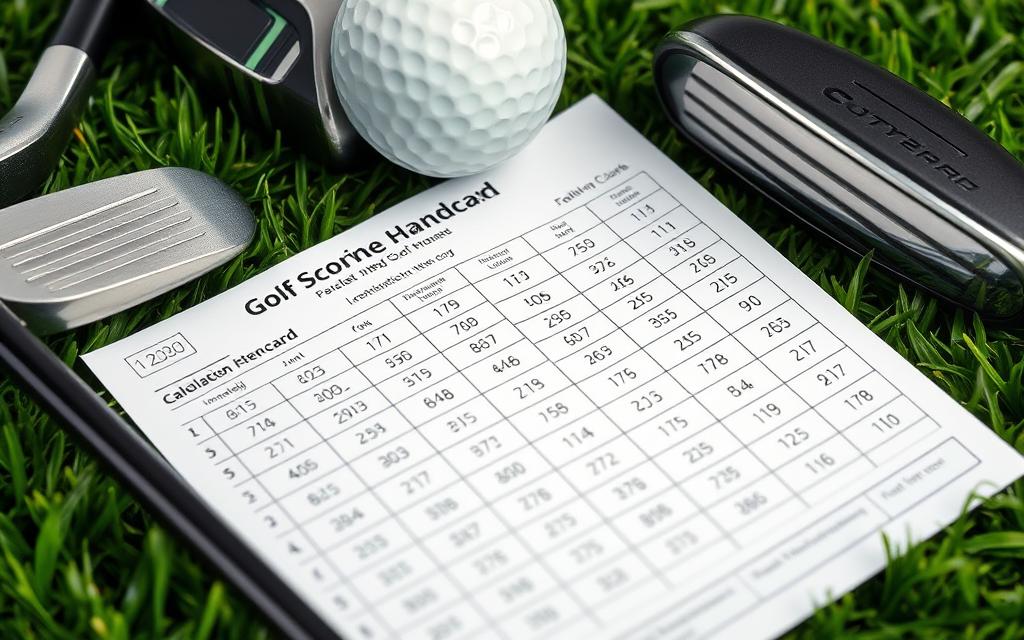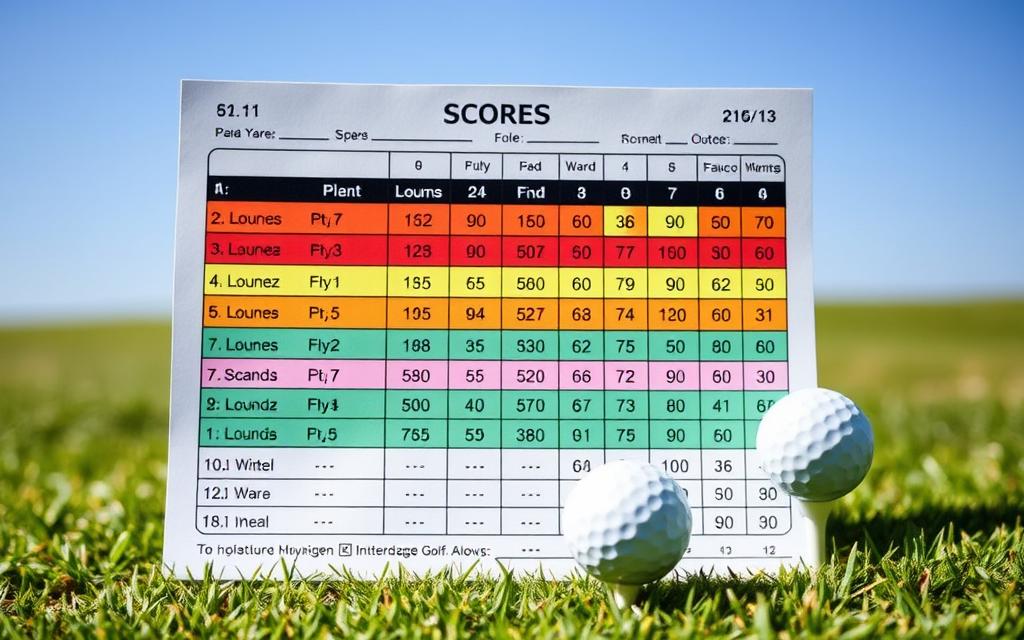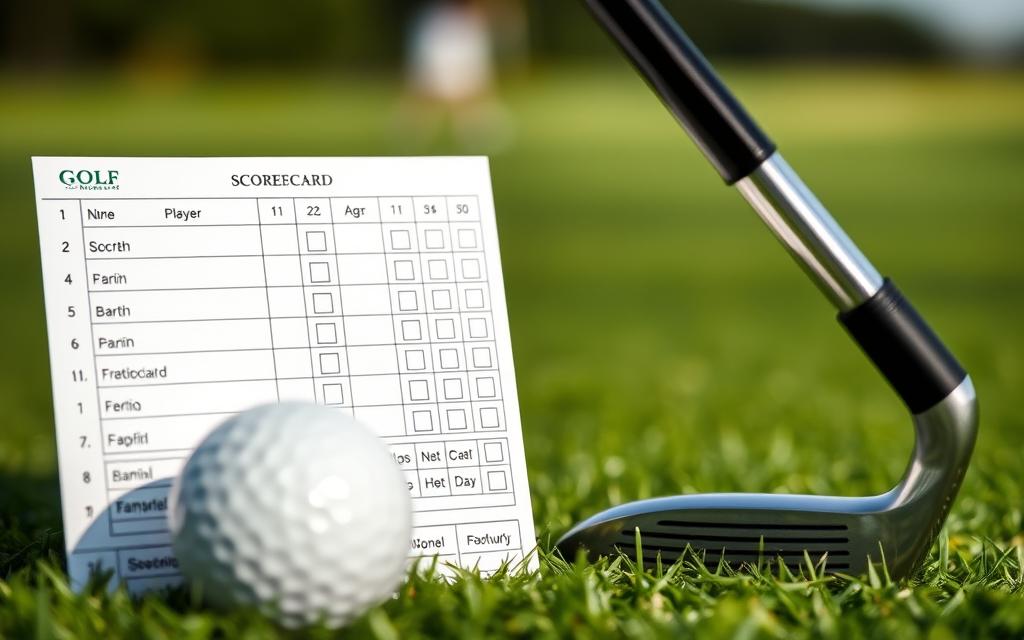Are you a golfer confused by the numbers and symbols on your scorecard? Do you wonder how your handicap changes your score and winning chances? Learn the secrets of golf handicapping and improve your game with this guide.
The golf scorecard is more than just your strokes. It’s a tool that can make the game fairer and better for you. We’ll explore golf handicaps, their purpose, how to calculate them, and how to use them. Get ready to become a scoring expert and play with more confidence.
Key Takeaways
- Understand the purpose and significance of golf handicaps in leveling the playing field
- Learn the step-by-step process for calculating your own handicap
- Discover how to read and interpret the information on a golf scorecard
- Explore the practical application of handicaps in different golfing formats
- Recognize the importance of accurate score-keeping and its impact on your handicap
- Debunk common misconceptions about golf handicaps and their rules
- Explore tools and resources to effectively manage and improve your handicap
Understanding Golf Handicaps and Their Purpose
Golf handicaps are key to the game. They make sure everyone has a fair chance to play. Let’s explore what they are and why they matter.
What Is a Golf Handicap?
A golf handicap shows how good a player is. It’s based on how well they’ve played before. It tells how many extra strokes a player needs to beat the course’s par.
Why Use a Golf Handicap?
Handicaps help players of all levels play together. They make the game fair and fun for everyone. This way, everyone can enjoy playing golf.
How Handicaps Level the Playing Field
The course rating and slope rating help figure out a player’s handicap. The course rating is for a perfect golfer. The slope rating shows how hard the course is for a beginner. Together, these ratings and a player’s past scores set their handicap. This handicap is then used to adjust their score during a game.
“Handicaps allow players of different skill levels to compete against each other on a more equitable basis, making the sport more inclusive and enjoyable for everyone.”
Handicaps make sure skilled players help out their less skilled opponents. This way, the game stays fun and fair for everyone. It makes golf a great experience for all players.
How to Calculate Your Golf Handicap
Calculating your golf handicap is key to playing fairly and enjoying the game. It helps you know your skill level. This way, you can play on equal terms with others. Let’s look at how to calculate your handicap.
Steps for Calculation
- Track your scores for at least 5-20 rounds of golf, depending on your governing body’s guidelines.
- Identify the course rating and slope rating for each course you’ve played on.
- Use a standardized formula to calculate your handicap index based on your best scores.
- Apply any necessary adjustments or factors to determine your final handicap calculation.
Adjustments for Different Courses
The course rating and slope rating are key in calculating your handicap. They show the course’s difficulty. This ensures fair play across different courses. Always record the course rating and slope rating accurately.
Guidelines for Score Submission
Following score submission guidelines is vital for an accurate handicap. This might mean reporting scores to your local club or using an online system. Sticking to these rules keeps your handicap current and fair.

Understanding how to calculate your handicap is important. It helps you play fairly and enjoy the game more. Remember, keeping accurate records and submitting scores properly is essential for a reliable handicap.
Reading Your Golf Scorecard
Learning the golf scoring system can really help you play better. First, you need to know how to read your scorecard. This guide will show you the important parts of a scorecard. It will help you understand your golf scoring system better.
Key Sections of a Scorecard
The golf scorecard has a few key parts:
- Hole number
- Par for each hole
- Your gross score for each hole
- Total gross score for the round
- Your handicap and the adjusted net score
Understanding Par, Birdies, and Bogeys
The golf scoring system centers around par. Par is the number of strokes a good golfer should take for a hole. If you score lower than par, it’s a birdie. If you score higher, it’s a bogey.
Keeping track of these scores can help you see how you’re doing. It shows you where you might need to get better.
The Role of Your Handicap on the Scorecard
Your golf handicap is key to figuring out your net score. By subtracting your handicap from your gross score, you get your net score. This score is how you compare with other players and figure out tournament results.
Knowing how your handicap works in the golf scoring system is important. It helps you enjoy the game more and do better.
Applying Your Golf Handicap During a Match
Your handicap is key in golf. It helps you know how well you’ll do in a match. Let’s look at how handicaps work in different golf games and how they affect your score.
Using Handicaps in Different Formats
Golf games come in many styles, each with its own rules and how handicaps are used. In stroke play, your handicap changes your score. This makes games fair for all players. In match play, your handicap gives you strokes based on your skill and the course’s par. This game focuses on each hole.
Stroke Play vs. Match Play
In stroke play, the player with the lowest net score wins. Your handicap is subtracted from your score to get your net score. For example, if you score 90 and have a 12 handicap, your net score is 78 (90 – 12 = 78).
In match play, the player with the fewest strokes on each hole wins that hole. Your handicap decides how many strokes you get, based on the course’s par.
Determining Net Scores
Figuring out your net score is easy. Just subtract your handicap from your gross score. This works for both stroke and match play. Some games use the Stableford scoring system, where points are based on how well you do compared to par, with your handicap affecting your total score.

Knowing how your handicap works in different games helps you play better. It makes games fairer and lets you compete with others more evenly. Learning about net scores will help you use your handicap well and enjoy golf more.
The Importance of Keeping Accurate Scores
Keeping accurate golf scores is key for the game’s integrity. The golf scoring system and handicap calculation are the base of fair play. Following the USGA handicap rules helps show your true golfing skill and keeps the game fair for everyone.
Why Accuracy Matters
Accurate scoring is more than just good manners. It helps you track your progress and get better at golf. Your handicap, based on past scores, is vital for fair play. Wrong scores can mess up your handicap, making the game unfair.
Record Keeping Tips
- Diligently record each shot on your scorecard, including strokes, putts, and any penalties incurred.
- Double-check your scores at the end of each hole and round to ensure no mistakes have been made.
- Regularly submit your scores to your golf club or the USGA handicap system for updates and adjustments.
The Impact of Errors on Your Handicap
Scoring errors can greatly affect your handicap. A wrong handicap can give you an unfair edge or make it harder to compete. Keeping accurate records is key to a fair handicap that shows your true golfing skills.
“Keeping accurate scores is not just a matter of etiquette; it’s a fundamental aspect of the game that ensures fairness and integrity.” – [Expert Golfer]
Common Misconceptions About Golf Handicaps
Golf handicaps often lead to confusion. We’ll clear up some myths and explain the USGA rules. This will help you understand golf handicaps better.
Debunking Myths
Many think a lower handicap means you’re better at golf. But, it’s not that simple. Your skills can change based on the course, who you play with, and how you’re feeling that day.
Clarifying Common Questions
- Do I need to be a member of a golf club to have a handicap? No, you don’t. The USGA handicap system is open to all golfers, regardless of club membership.
- How often should I update my handicap? Your handicap should be updated after each round of golf, based on your most recent 20 scores. This ensures your handicap accurately reflects your current playing ability.
- Can I use my handicap at any course? Yes, your USGA handicap can be used at any golf course that has an established course rating and slope rating.
Understanding the Rules
The USGA rules make golf fair and consistent. Knowing these rules helps you use your handicap well. It makes golf more fun for everyone.
| Myth | Fact |
|---|---|
| A lower handicap always indicates a better player. | Factors like course conditions, playing partners, and personal form can influence a golfer’s handicap. |
| You need to be a member of a golf club to have a handicap. | The USGA handicap system is open to all golfers, regardless of club membership. |
| You can use your handicap at any course. | Your USGA handicap can be used at any golf course that has an established course rating and slope rating. |
We aim to help golfers understand their handicaps better. This way, golf can be more enjoyable and fair for everyone.
Tools and Resources for Managing Your Handicap
Keeping track of your golf handicap is key to improving your game and playing fairly. Luckily, many tools and resources help you manage your golf scoring system and handicap calculation well.
Apps and Software to Track Your Scores
Today, many apps and software make it easy to record and manage your golf scores. They follow the USGA handicap rules, making it simple to input your rounds and get accurate handicap updates.
- Golf Handicap and Information Network (GHIN): An official USGA-endorsed app that helps you track your scores and maintain your handicap.
- The Grint: A popular app that offers score tracking, handicap calculation, and course management features.
- Arccos Golf: A sensor-based system that automatically logs your shots and provides detailed analytics to improve your game.
Finding Local Golf Clubs for Handicap Services
Many local golf clubs offer handicap services for their members. This makes it easy to manage your golf handicap. The clubs have staff who can help with the handicap calculation and explain the USGA handicap rules.
To find a local golf club with handicap services, search online directories or contact your regional golf association. You can also visit the USGA’s website to find clubs near you.
Online Resources and Communities
There are also online resources and communities to help with your golf handicap. These platforms offer tips, advice, and forums to connect with other golfers. They help with golf handicap management and golf scoring system strategies.
- USGA Handicap System: The official website of the United States Golf Association, which provides detailed information on the USGA handicap rules and guidelines.
- GolfWRX: A popular online forum where golfers discuss various topics, including handicap management and golf scoring system strategies.
- Golf Digest: This renowned golf publication offers articles and resources on different aspects of the game, including handicap calculation and golf handicap improvement.
By using these tools and resources, you can make managing your golf handicap easier. You’ll stay updated on the latest USGA handicap rules. Plus, you’ll connect with a community of golfers who love the game as much as you do.
Tips for Improving Your Game and Lowering Your Handicap
To get better at golf and lower your handicap, focus on a few key things. Start by practicing in a smart way. This means working on specific parts of your game.
Also, think about getting a golf coach. They can give you advice and help you find and fix your weak spots.
Practice Strategies
Practicing regularly is important for improving your golf. Work on your swing, getting your club head speed up, and hitting the ball straight. Do drills to get better at putting, chipping, and playing from the bunker.
Working with a Golf Coach
Having a good golf coach can really help you. They can look at your swing and tell you how to improve. They give you tips that fit you, helping you get better faster.
Setting Realistic Goals
Set goals that you can really reach. Maybe you want to lower your handicap by a few strokes. Or maybe you want to get to a certain course rating. Having goals keeps you motivated and helps you see how far you’ve come.


